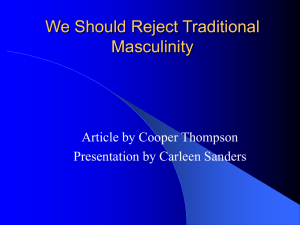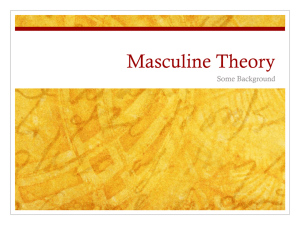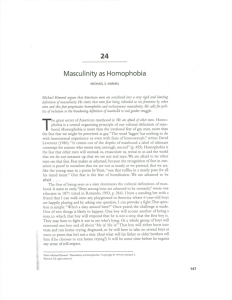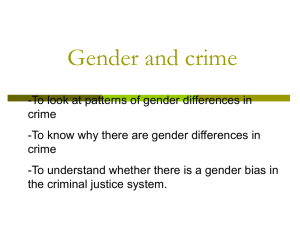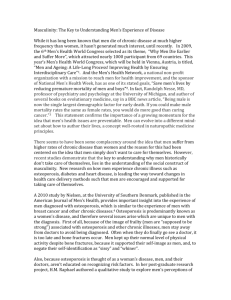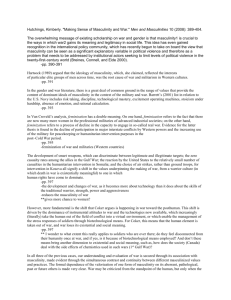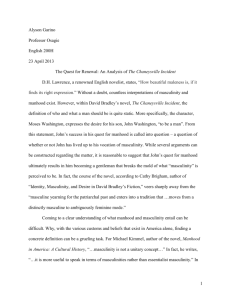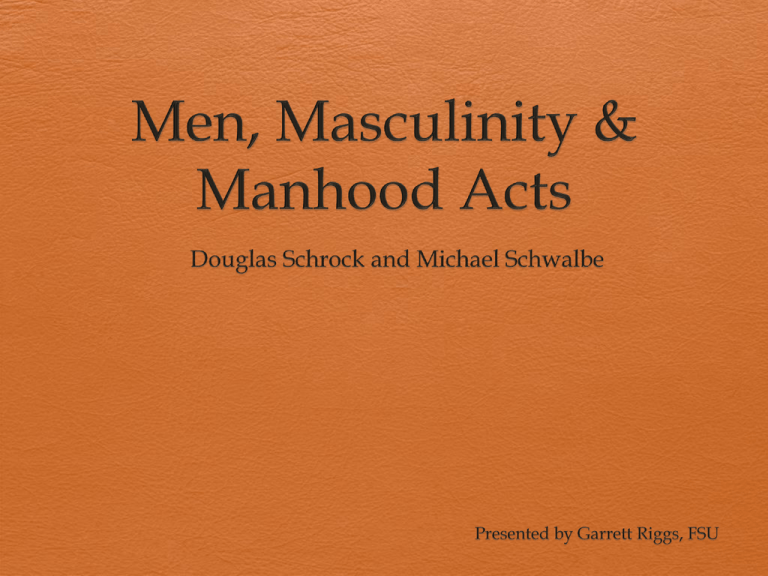
Learning objectives
Describe pre-1980s concept of masculinity
Describe concept of multiple masculinities
Understand how generalized notions of masculinity (and,
by extension, femininity) are problematic
Describe how boys learn masculinity through socialization
Describe how gender affects power/position in society
Infer how feminism and masculinity studies interact
Masculinity pre-1980s
Prior to the 1980s, masculinity and femininity were often
considered tied to one’s physical sex.
Masculinity and femininity were seen as personality traits
and behaviors and were associated with sex roles.
What was left out
of the pre-1980s discussions?
Discussion of power and subordination in gender roles
What men actually do in groups and as individuals that
helps them identify as men
Plurality & its problems
Definitions as used by Schrok and Schwalbe:
Male—biological state based on reproductive anatomy.
Men—Males who claim rights and privileges of the “dominant gender group.”
Masculinity—the individual’s self-concept as male and the signification of that
possession.
Post-1980s, scholars began to describe specific versions of
masculinity—i.e., black, Jewish, working-class, and gay. While
this moved the concept of masculinity and manhood away from a
singular model (usually white middle class heterosexual males), it
still described male experience within the various groups in
generalized terms and didn’t accommodate the actual diversity of
male experience (i.e. a gay man with multi-racial roots).
Signifying the
masculine self
Socialization of roles starts with external affirmations—for
example, adults praising “big boy” behavior in toddlers.
Parents, teachers, and peers reinforce gender roles—boys
are directed toward trucks and clothes designed for boys.
The boy who experiments with nail polish is scolded or
teased.
By elementary school, boys and girls self-segregate or, when
playing together, boys often engage in play that emphasizes
the difference between boys and girls and an assumed
superiority of boys over girls—e.g., a game of dodge ball
where physical power and speed are essential.
Signifying the
masculine self
Young males learn to control their emotions, a behavior that is
enforced by both peers and parents. For example, boys who cry
are ostracized by peers.
Boys and young men are encouraged to present themselves as
aggressively heterosexual. They use homophobic taunting to
regulate each other’s behavior.
Aggression and violence is admired in males; young boys may
express this in imaginative “good vs. evil” play.
Males learn to read and play to an audience’s expectations of them
as men—i.e., a physical laborer who prides himself on strength,
endurance, and resistance to being bossed around.
Learning from the Media
Boys in elementary school may concentrate on superheroes.
In middle school, boys may switch to discussing and
emulating male heroes in movies.
Power is glorified in children’s media designed for boys.
Media aimed at adolescent and young men often roots
manhood in a voracious heterosexual appetite, work, and
hypermasculine bodies.
Media also tends to idealize the white heterosexual monied
man. Men of other backgrounds or groups are marginalized
in mainstream media.
Manhood Acts
Research on transsexuals—particularly the female-to-male—
showed that when biological females adopt the gestures,
clothing, and mannerisms of males, they often gain social
power (especially if they present themselves as traditional
heterosexual men and happen to be white).
Middle- and upper-class men often invoke their position as
the family provider to avoid childcare and housework.
Even in lower-class households, men use strategies such as
violence to maintain control of the relationship; men of all
classes may use emotional withdrawal as a form of control.
Manhood acts
In the workplace, men in management may use a
paternalistic demeanor or strive to show rationality, resolve,
and competitiveness.
Men in lower positions may assert their masculinity by
refusing to be bossed around.
Women are sexualized as a way to assert male
heterosexuality, both to maintain power and to avoid being
abused by peers.
Openly gay men may value muscularity and macho fashion
as a way to retain a position of power that does not rely on
sexuality.
Reproducing gender
inequality
In traditional expression of masculinity, men strive to show
a capacity for exerting control over self, the environment,
and other people.
Manhood acts are how men distinguish themselves from
women, establishing their eligibility for gender-based
privilege.
The hegemonic ideal may serve men in the workplace as
they seek promotion and privileges afforded to men.
In political and social realms, men benefit from appearing to
conform to the hegemonic ideal of masculinity.
Suggestions for research
Manhood acts can be detrimental to men as high-risk
behaviors put them at higher risk of death, suicide, or to be
without social and emotional support.
Research needs to make distinctions between anatomy, sex,
and gender categories.
Studying how manhood acts are institutionalized may shed
light on how men collaborate to construct masculinity in
changing times.
Discussion ideas
How does the digital age change manhood? For example, do
social networks or online gaming change how young men
collaborate and regulate each other’s behavior?
How can we discuss masculinity in terms that don’t automatically
negate the feminine? For example, why does “male” or
“masculine” often automatically equal “not-female” (i.e., using
phrases like “you throw like a girl” or “he cried like a little school
girl” to belittle a man)?
In the four years since this article was originally published, we
have seen more diverse visions of masculinity in mainstream pop
culture. In what ways has this changed the definition of
“manhood” and “manhood acts” as used by the authors?

